Based on a reading from User Friendly.
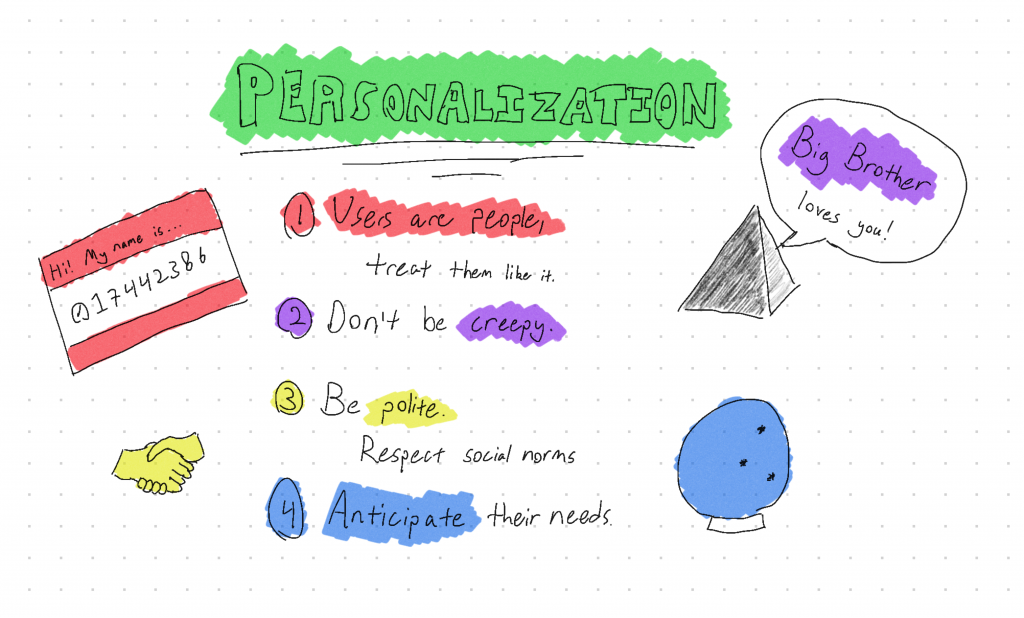

Based on a reading from User Friendly.


At long last, I am quite happy to share that Fluidics 2.0 is now available on the App Store. If you’d like to see the full feature list, check out the release post over on the new Fluidics website; this is going to be more of a ‘making of’ sort of post.
So, what’s new in Fluidics 2.0 that warrants it being Two Point Oh?
To start with, I rewrote it from the ground up. Which is widely considered to be a bad idea, but I stand by the decision. I built Fluidics as a project in undergrad; while that wasn’t all that long ago, I’ve learned a great deal since then.
And beyond that, the iOS world has changed. Fluidics 1.0 was built on storyboards and imperative programming; Fluidics 2.0 is entirely SwiftUI. (The only storyboards present are in the widgets, which… cannot be built without storyboards. Maybe in SwiftUI 2.0?)
And while I wanted the core of the application to stay the same – I love the visual of the screen filling up, and the way the colors transition from the ‘above water’ to ‘under water’ areas never fails to make me smile – I also wanted some of the more idiosyncratic stuff to… fit in better.
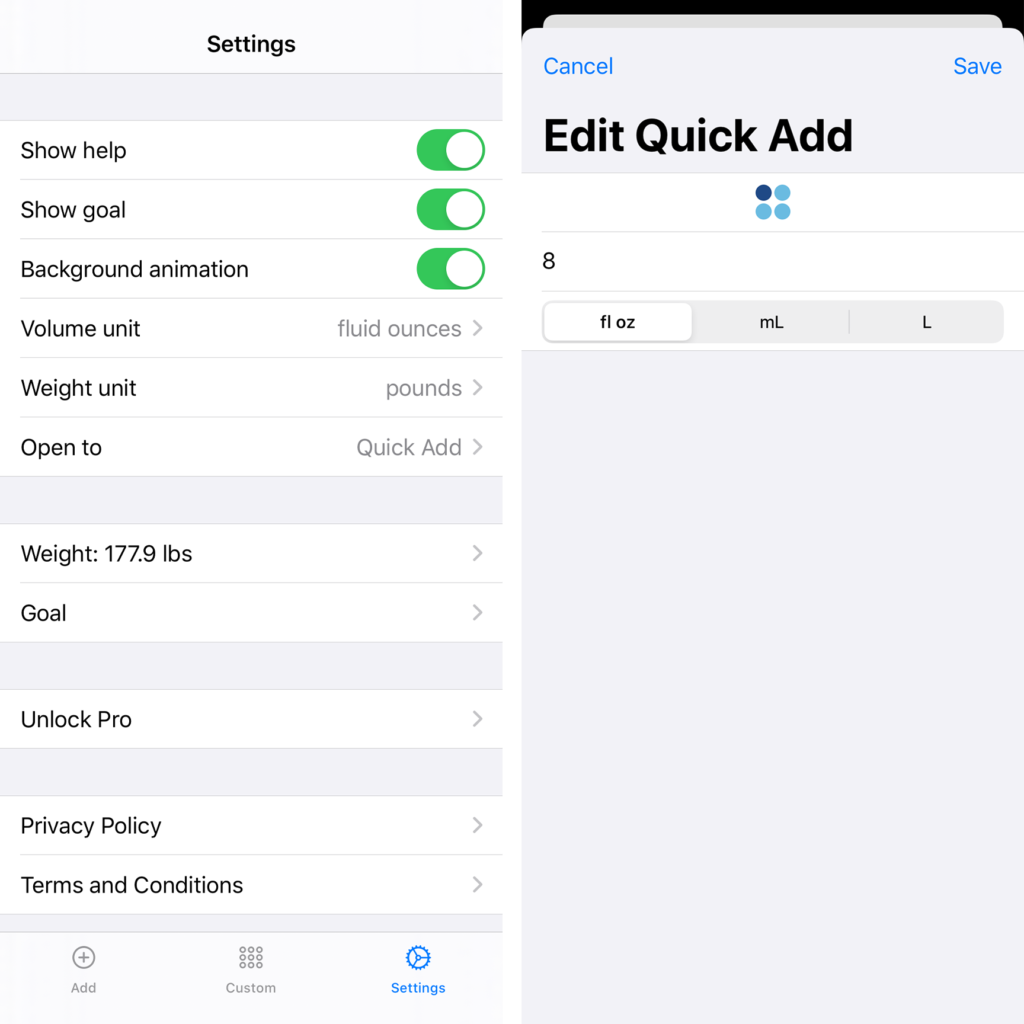
Gone are the cards.
Settings is now a full-screen experience, and that extra room to breathe makes for a lot easier navigation.
For the Quick Add, I went with the new style of cards in iOS 13, which are just as easy to dismiss thanks to the universal swipe-down gesture, and have fewer… weird bugs.
One of the key ideas of the design program I’m doing right now is that “you are not your user.”
Which, in this case, meant I had to buckle down and accept what my actual users kept telling me. Cool as I think it is to swipe from screen to screen, other people mostly just found it confusing. Tabs? Tabs are standard for apps, which makes them easy to understand; they’re also very well-integrated with VoiceOver, which is something the swiping always struggled with.

SwiftUI also comes with effectively free Dark Mode support. Most of the actual work, for me, was in finding slight variations on the colors that looked as good in Dark Mode as the originals did in Light Mode. (Day Mode?)
Finally, this new version of Fluidics is something like a tenth the size-on-disk of the previous. This comes from a few places: some actual clean-up work I did helped, but the biggest gains were from updating to the latest version of Swift; that means that, instead of including Swift itself in the app, I can just use the system-level one. So it’s iOS’ problem to keep track of that whopping couple of megabytes of code, and not Fluidics’. Nice.
Similarly, switching to iOS-standard cards instead of the custom ones saves some room. While I was working on dependencies, I switched from a weird, all-local, very-unstable implementation of StoreKit to RevenueCat, which is much easier to work with and saved me a great deal of tearing out my hair.
The final big change was a bit of a side project itself: a new website for Fluidics. The old one was… fine, I suppose. It gave me a chance to try out static site generation with Jenkins (on GitHub Pages), but… hand-coding HTML and CSS, while something I can do, isn’t something I really enjoy doing.

In the interim, however, WordPress has had some excellent updates, the Twenty Twenty theme is easy enough to tweak, and Gutenberg with some plugins makes for a very good editing experience, so here we go.
The new site looks better, and makes it a lot easier for me to do things like, say, having a blog where I can do visually-interesting update notes for each release.

A quick post of a class assignment we did a while back – tinkering with data visualization. I went with my travels and my playlists as the data sources.

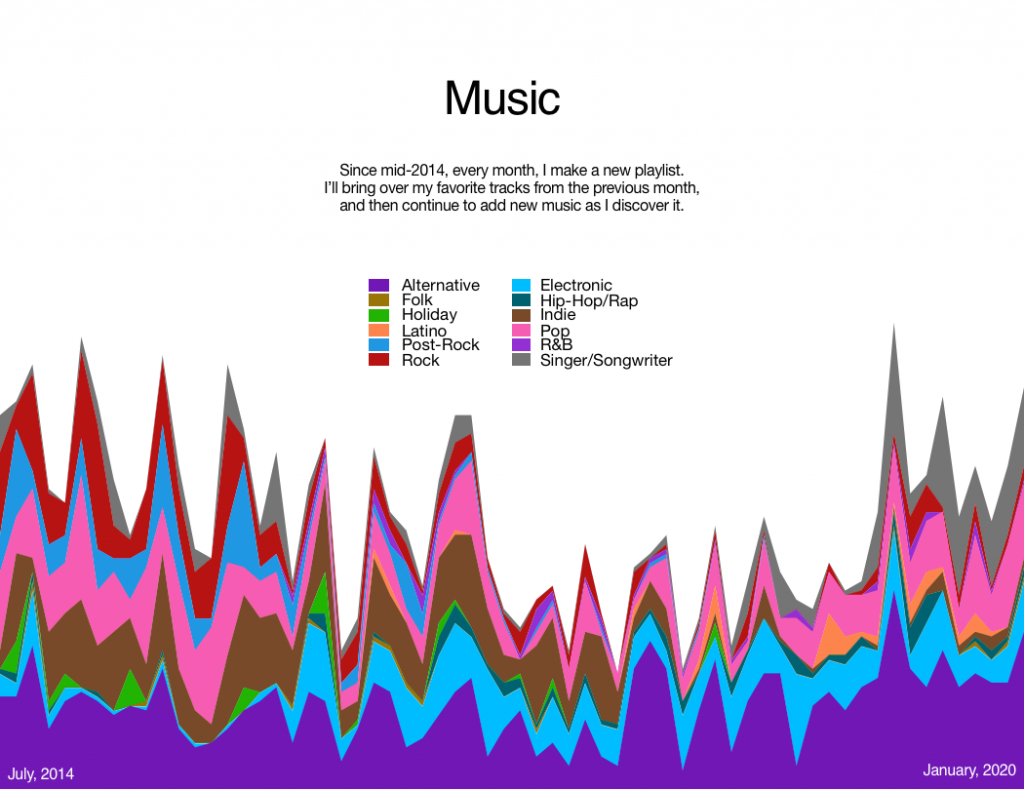
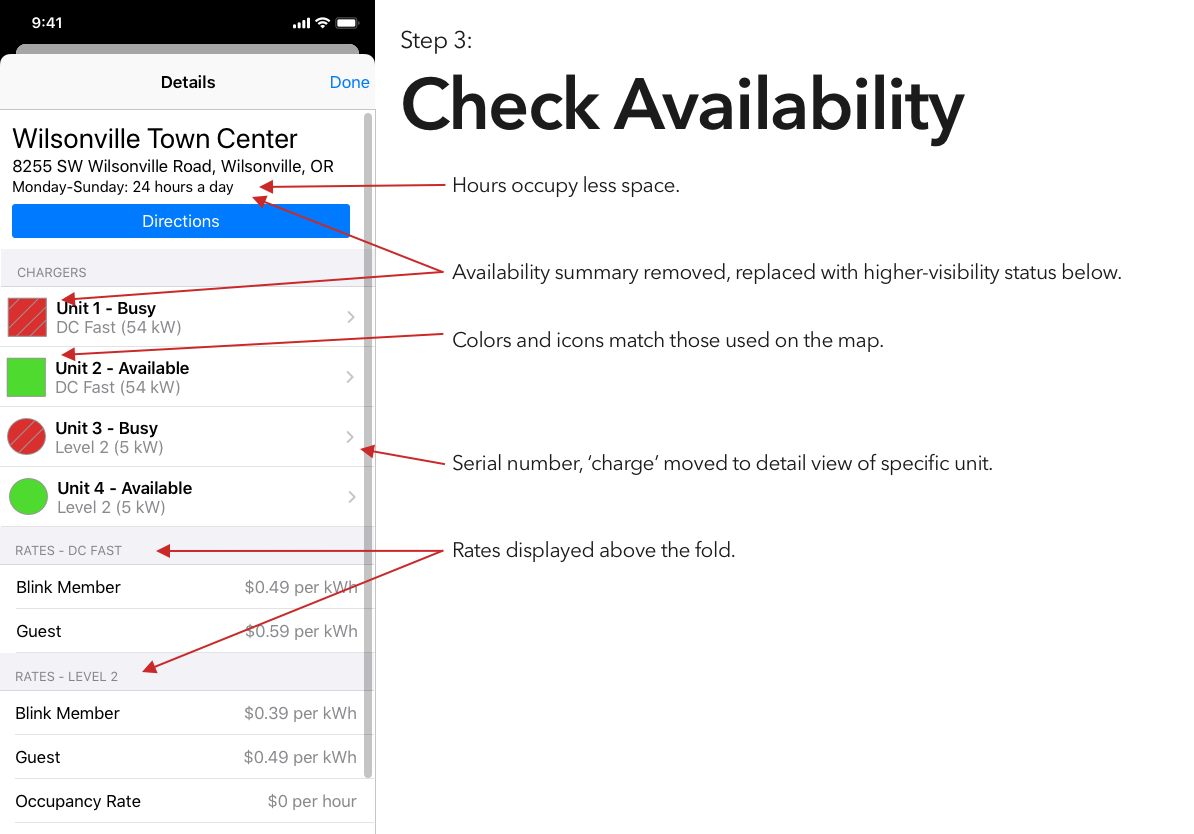
It’s been interesting to watch electric vehicles grow in popularity, a trend that I expect to continue unless someone decides to pour marketing money on hydrogen. That said, aside from Tesla’s Supercharger network, EVs are seriously lacking an answer to the refueling infrastructure of gasoline vehicles.
I’ve tried a couple of the different commercial offerings, and have so far found them all to be a horrible user experience. (Current winner? The charging stations at the public library, which were installed recently enough that they haven’t been activated. There’s no sign to indicate that, no information on the stations’ display screens, and if you call their support to ask “what’s the deal?” they’ll tell you that “those stations were decommissioned.”)
Blink is, at least in my area, the most robust charging network, and thus is the only one whose app I’ve bothered to try. And it is… not great.
So, continuing on in the proud Design Student tradition of uninvited redesigns, here’s my takedown and redesign of Blink’s app. (And hey, if someone from Blink is reading this – send me an email, I’d be happy to flesh this out a bit more. Or write some of the code.)
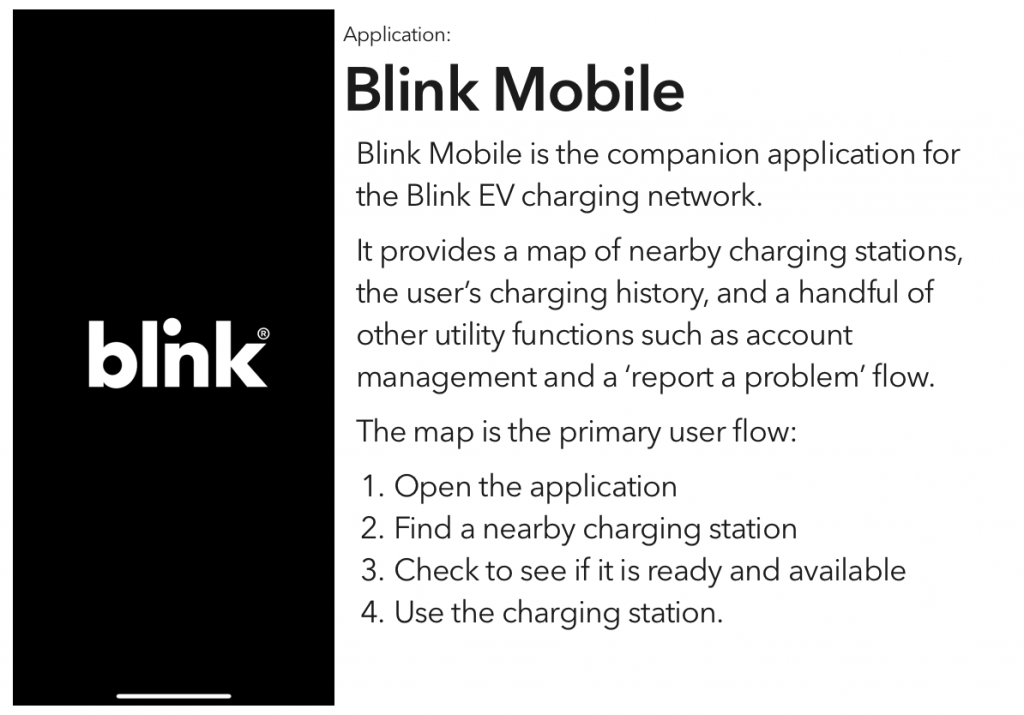





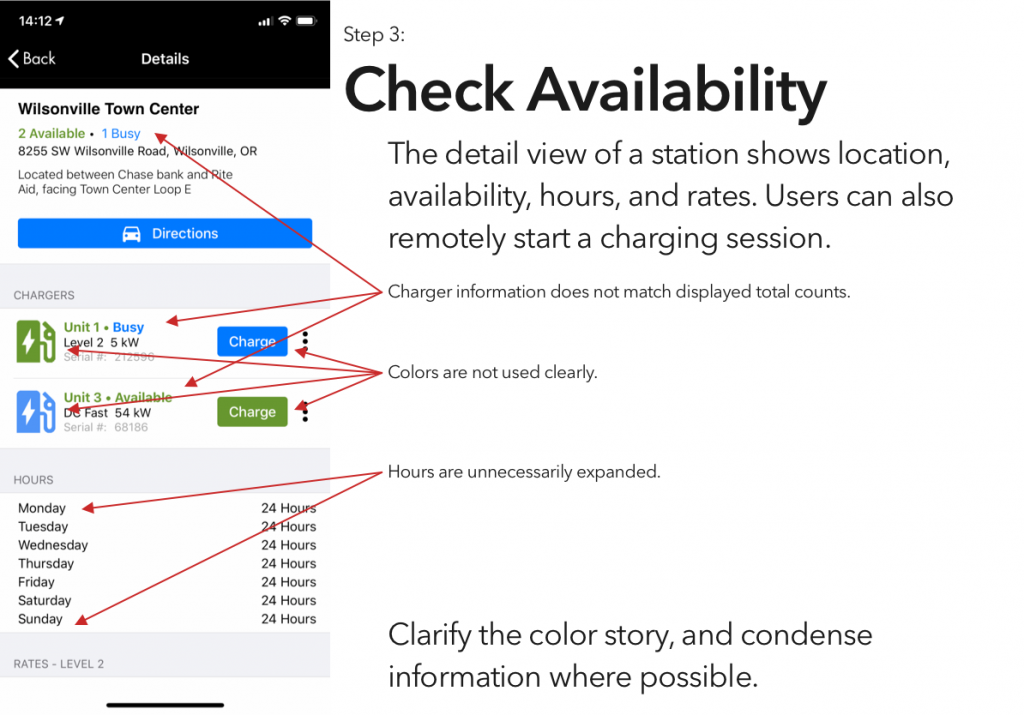






Also available as a PDF, if that’s your jam:
These playlists have been getting longer over time. Eventually I’m going to wind up just posting a list of every song in my library.1
Cologne – Haux on Something to Remember – EP
Sober – Edwin Raphael on Sober – Single
Coincidental – Betcha on Coincidental – Single
Falling Down – Harrison Storm on Falling Down – Single
Angel – H. Kenneth on Angel – Single
F**k Collingwood – Hayden Calnin on F**k Collingwood – Single
Haunted – Saint Claire on Haunted – Single
On Our Last Day – Hayden Calnin on A Life You Would Choose – EP
Hard Lines, Hard Times – William Wild on Hard Lines, Hard Times – Single
Without Fear – Dermot Kennedy on Without Fear
everything i wanted – Billie Eilish on everything i wanted – Single
Dolly Zoom – Elliot Moss on Boomerang
Don’t Take the Money – Harry Strange on Don’t Take the Money – Single
This is Where it Ends – Richard Walters on This is Where it Ends – Single
Borders – Nathan Ball on Borders – Single
Eight – Haux & Rosie Carney on Eight – Single
Chanel – Frank Ocean on Chanel – Single
notice me (feat. BENEE) – ROLE MODEL on oh, how perfect – EP
Take Me Apart – SYML on Take Me Apart – Single
Apollo – Charles Fauna on Yonder
Lies (feat. H. Kenneth) – Syence on Lies (feat. H. Kenneth) – Single
Blinding Lights – The Weeknd on Blinding Lights – Single
Rapide – Mahmood on Rapide – Single
Circles – Post Malone on Hollywood’s Bleeding
Wherever You Are – Kodaline on Wherever You Are – Single
Middle of the Night – Elley Duhé on MIDDLE of the NIGHT – Single
Soil’s Daughter – Aisha Badru on Soil’s Daughter – Single
Higher – Byron Langley on Light On – EP
Magic in the Hamptons (feat. Lil Yachty) – Social House on Magic in the Hamptons (feat. Lil Yachty) – Single
Tremors – SOHN on Tremors
Let Me Down – Run River North on Monsters Calling Home, Vol. 2 – EP
I Gave It All – Aquilo on Painting Pictures of a War – EP
twenty four seven (feat. John McDonald) – Andy H on twenty four seven (feat. John McDonald) – Single
The Box – Roddy Ricch on Please Excuse Me For Being Antisocial
Falling (blackbear Remix) – Trevor Daniel & blackbear on Falling (blackbear Remix) – Single
Somewhere (feat. Octavian) – The Blaze on Somewhere (feat. Octavian) – Single
Slowly – ODIE on Slowly – Single
hertz – EDEN on no future
Lie – Jake Scott on Lie2
Love Me (feat. Haux) – Smeyeul. & Galvanic on Love Me (feat. Haux) – Single
Better Off Without You – Aquilo on Painting Pictures of a War – EP
Where There Is Love, There’s Hope – Aron Wright on Where There Is Love, There’s Hope – Single
The Night We Met – Alle Farben on The Night We Met – Single
ROXANNE – Arizona Zervas on ROXANNE – Single
All My Life – William Wild on Rental House / All My Life – Single
2020 – Great Good Fine Ok on 2020 – Single3
Hurts Like Hell – Wrabel on Hurts Like Hell – Single
Be Slow – Harrison Storm on Be Slow – Single
no one wants to dance anymore (feat. Yung Pinch) – johan lenox on cancel the party
Losing You – Aquilo on Painting Pictures of a War – EP
Sorry – Declan J Donovan on Sorry – Single
Pines – ferdinant. on Pines – Single4
Never Seen You Get So Low – Aquilo on Painting Pictures of a War – EP
New Shapes (feat. Octavian) – Diplo on Europa – EP
White Morning – Seoul on I Become A Shade
Out the Other Side – Future Thieves on Emotional Cost
Roll Dice – Roddy Ricch on Please Excuse Me For Being Antisocial
Hue – SOHN on Hue / Nil – Single
Prayers to the Trap God – Roddy Ricch on Please Excuse Me For Being Antisocial
Waiting – Aquilo on Painting Pictures of a War – EP
Someone to Watch Over Me – Col3trane on Someone to Watch Over Me – Single
Dogcatcher – Elliot Moss on A Change in Diet5
Father Daughter Dance – Kesha on High Road
Stubborn – Daniel Allan & Jake Neumar on Stubborn – Single
No Time To Die – Billie Eilish on No Time To Die – Single6
Human – Aquilo on Painting Pictures of a War – EP
Wash Away the Wild – KAWALA on KAWALA – EP
Love Me Wrong – Allie X & Troye Sivan on Cape God
Sober – Aquilo on Sober – Single7
me & ur ghost – blackbear on me & ur ghost – Single
Slow Ride (feat. H. Kenneth) – Nick Martin & H. Kenneth on Slow Ride (feat. H. Kenneth) – Single
Explain You – JP Saxe on Hold It Together – EP
Four in the Morning – Harry Strange on Four in the Morning – Single
Make It Easy on You – Aron Wright on Make It Easy on You – Single
Girls – Balcony on Girls – Single8
not ur friend – Jeremy Zucker on not ur friend – Single9
No Alibi – Benji Lewis on Here, Then and Now – EP
Light Again – bobbycrush on Light Again – Single
Baby Girl – Bryce Vine on Baby Girl – Single
Numb – Elderbrook on Numb – Single
Tongue In the Bag – XYLØ on The Ganglands of My Heart – EP
2020 – EDEN on no future
Faith – The Weeknd on After Hours
Hardest To Love – The Weeknd on After Hours10
Where Do We Go When We Die – Quinn Lewis on Where Do We Go When We Die – Single
After Hours – The Weeknd on After Hours
Morning Prayers – Steve Benjamins on Morning Prayers – Single11
bad guy – Billie Eilish on WHEN WE ALL FALL ASLEEP, WHERE DO WE GO?
when the party’s over – Billie Eilish on WHEN WE ALL FALL ASLEEP, WHERE DO WE GO?
bury a friend – Billie Eilish on WHEN WE ALL FALL ASLEEP, WHERE DO WE GO?
Oh My My – Blue October on Oh My My – Single
In Your Eyes – The Weeknd on After Hours (Deluxe)

Dark Patterns are tricks used in websites and apps that make you do things that you didn’t mean to, like buying or signing up for something.
Dark Patterns
For a recent class assignment, we had to choose three dark patterns, find a site or service using each one, and then propose an alternative version that didn’t use that dark pattern.
You may notice that I’ve actually done four here – the last one was an interesting variant on some of the example dark patterns, and I wanted to explore that a bit.








You can also download a PDF of the presentation – it will work better in screen readers:
In the past couple months, I’ve had an ongoing series on converting iTunes playlists to text files, with a brief digression into scripting with Swift. While I doubt that I’m entirely done with the topic, I have reached a point where I’m ready enough to do another write-up.
This morning, I made playlister available to the public. It is not a consumer-facing application like my others; it is very much a tool for people who are comfortable with the command line.
In between the previous iteration of this tool and the current, I actually had a version of playlister built and shareable (Chase has that version installed on his Mac, actually) but, before releasing it to the public, I looked at the code and thought “I can do better.”1
So I buckled down and spent some time indulging in my love for API design, and tried some tricks I’ve been wanting to try.
The rewritten version ships with a library, LibPlaylister, that provides the basic ideas — protocols that allow for interacting with the library, playlists, and tracks; conversion to Markdown — as well as some neat new tricks. There’s some hooks for customization, such as the RatingFormatter protocol, and included FiveStarRatingFormatter, and the new LinkStore protocol, which provides a layer of abstraction on the SQLite-based caching of links.2
It was also an excuse to add to my Swift toolbox. I worked with SwiftCLI for a while, and then converted to ArgumentParser when that was released. I’ve done file interactions, and a lightweight database. I’ve learned a lot about Swift Package Manager.3 I learned a bit about XCTest, and figured out how to get it working in GitHub Actions. (And, more interestingly, figured out how to conditionally include frameworks in an SPM package. I wanted the tests running on Linux, but Linux… doesn’t have the iTunesLibrary framework, shockingly.)
I had fun building this, and will probably continue to tweak it. (I mean, it could be fun to get it automatically pulling links from the iTunes Search API, and just asking ‘is this the right link?’ instead of requiring manual entry.4)
For now, though, it’s ready enough to share, and made for a fun write-up and a good way to de-stress by tinkering.
xattr -d com.apple.quarantine ./playlister ↩package.json format at work, SPM Package.swift files are nice. Like, you can have comments in them! And, more, you can have actual code, so you can do neat stuff like this. ↩LibPlaylister a separate library. ↩I am rather bad at the whole concept of relaxation. I say this as an introduction, because writing this post is my idea of taking a break from putting together the final presentation for my class on user testing.
The course has been interesting overall. I will readily admit that I don’t intend to make a career of user research, but I am glad I’ve had the experience. Research is, after all, critical to design and development both. We can try to stick to the whole “if we asked people what they wanted, they would’ve said ‘a faster horse’” thing, but, shockingly, we actually aren’t omniscient. We aren’t our users.
Throughout the course of the course (and now you can tell my brain is a bit fried, because I’m throwing in wordplay), we’ve used a few different techniques. My favorite so far has been card sorting: it’s easy to explain, quick to do, and works very well for figuring out a sensible way to organize a bunch of stuff.1
I also quite enjoyed the competitive analysis assignment—going through, as best as I could, the entire market for a specific category was a surprisingly fun challenge. It’s also immediately visible how useful it is, from a strategic perspective: at the end of that assignment, I closed out an open project I had where I’d been putting together sketches for a fitness application. While it would’ve been fun to build, it really wouldn’t have had anything truly unique to establish itself in the market, and I’m too much of a Broke Millennial to be able to devote that much time to ‘fun to build.’2
We also did some quantitative and qualitative user testing, which I found interesting, but also served as the main argument for my “I don’t have a career as a researcher ahead of me” stance. Interesting, yes; useful, when done right; surprisingly difficult to do right, absolutely.
The qualitative structure was a bit more forgiving than the quantitative. We used UserTesting.com, which has a well-polished interface for assembling a test, a slightly less well-polished interface for going through a test, and a checkout page that leaked memory at an astonishing rate.34 Those complaints aside, the actual data I got was very helpful—the biggest issue I had with it was because of my own mistake, and the more open nature of the test meant that even that failure helped me sort out the answer to a different question I had.5
Going into the class, I thought I was going to like the quantitative testing more—I majored in computer science, and threw in a minor in math at the end, I’m a Numbers Guy. In execution, though, I wasn’t a fan. Part of this is probably due to the software we used: I was utterly unimpressed with Loop11. Their test assembly and reporting interface felt very Web 2.0, which I always find a bit alarming for an online-only business, and while the test-taking interface was a bit better (hello, Material Design 1.0!) it was unusable in Safari and a privacy disaster waiting to happen everywhere else.67 And for all that trouble, the data I got wasn’t all that useful. Though, a caveat to that: quantitative testing is more appropriate for summative testing, verifying that your completed design/product works as it’s supposed to, and I won’t be in a position to actually do that sort of testing for, oh, months at the earliest. Certainly not in time to use the results for this class, so I misused the technique a little bit in order to have something to work with.
As I said at the start, though I don’t intend to make a career of this, I’m glad to have taken the class—at very least, it means I’ll have that much more respect for the work my colleagues who do make a career of it are doing. And I sincerely doubt that this will be the last time that I do some testing myself; it’s important to do, and I quite like having the data to validate my designs.
I recently had the opportunity to attend a TEDx event. I’m not a big TED Talk person, but I’ve watched or listened to a few, so it was interesting to see a few in-person.
I also used the opportunity to practice my sketchnoting – the ones I’ve done in the past were at my leisure, so I figured it’d be a bit different at a live event.
Which it was – it’s harder to go back and edit when you’re trying to keep up in real time, and it’s a different approach to thinking about what you’re putting down.
I’m not sharing all of my notes here – for a couple of the talks, the notes I got weren’t really interesting in any way, or were too messy to be worth sharing.
Still, I enjoyed the experience, and I’m glad I went.
(As of this writing, the videos from the event are still being edited, so I don’t have direct links; check the TEDxMcMinnville site for updates.)
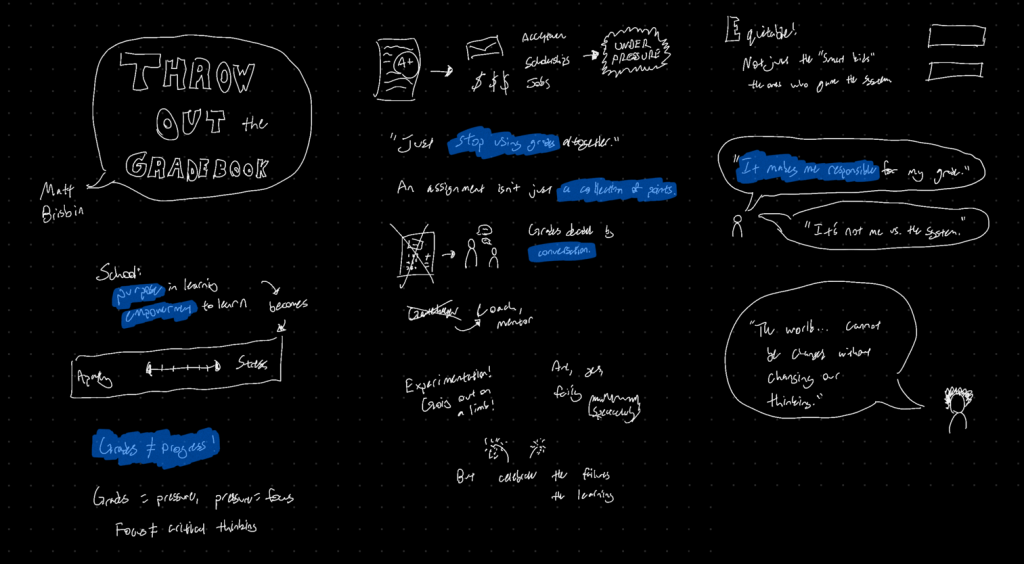

I’ll add here that I misspelled Cinthia’s name in the written version, for which I apologize.






Since last time I have rebuilt my system for doing these playlists… four times? Some people hike to unwind…
Cologne – Haux on Something to Remember – EP
Sober – Edwin Raphael on Sober – Single
Coincidental – Betcha on Coincidental – Single
Falling Down – Harrison Storm on Falling Down – Single
Angel – H. Kenneth on Angel – Single
Fuck Collingwood – Hayden Calnin on Fuck Collingwood – Single1
Haunted – Saint Claire on Haunted – Single
Crying at the Party – Harry Strange on Crying at the Party – EP
On Our Last Day – Hayden Calnin on A Life You Would Choose – EP
Hard Lines, Hard Times – William Wild on Hard Lines, Hard Times – Single
Without Fear – Dermot Kennedy on Without Fear
Hollow Coves – Firewoodisland on Hollow Coves – Single
Drive – OTR & Panama on Drive – Single
everything i wanted – Billie Eilish on everything i wanted – Single
Dolly Zoom – Elliot Moss on Boomerang
Don’t Take the Money – Harry Strange on Don’t Take the Money – Single
When I Need a Friend – Coldplay on Everyday Life2
This is Where it Ends – Richard Walters on This is Where it Ends – Single
Back Around – Harry Strange on Back Around – Single
Borders – Nathan Ball on Borders – Single
Silver + Gold – Elliot Moss on A Change in Diet
Eight – Haux & Rosie Carney on Eight – Single
Chanel – Frank Ocean on Chanel – Single
Swing – Sofi Tukker on Swing – Single
Hard Times (Acoustic) – RITUAL & Robinson on Hard Times (Acoustic) – Single
Million Pieces (feat. The Chamber Orchestra of London) – Bastille on Doom Days (This Got Out of Hand Edition)
notice me (feat. BENEE) – ROLE MODEL on oh, how perfect – EP
Lucky Me (feat. Great Good Fine Ok) – The Knocks on Summer Series: 2019 – EP
Take Me Apart – SYML on Take Me Apart – Single
Apollo – Charles Fauna on Yonder
Barricade – Elliot Moss on A Change in Diet
Rossetto – Random on Rossetto – Single
Sober – Harry Strange on Sober – Single
Stay – Alt Bloom on Stay – Single
Hvn – TEME on HVN – Single
Lies (feat. H. Kenneth) – Syence on Lies (feat. H. Kenneth) – Single
Bodyintoshapes – Elliot Moss on A Change in Diet
Blinding Lights – The Weeknd on Blinding Lights – Single3
hungover & i miss u – gnash on hungover & i miss u – Single
Chain – Lolo Zouaï on High Highs to Low Lows (Deluxe)
Top Dom – Avery Anthony on Top Dom – Single
Rapide – Mahmood on Rapide – Single
Rabbit Roads – Elliot Moss on A Change in Diet
Circles – Post Malone on Hollywood’s Bleeding
Wherever You Are – Kodaline on Wherever You Are – Single
Middle of the Night – Elley Duhé on MIDDLE of the NIGHT – Single
Soil’s Daughter – Aisha Badru on Soil’s Daughter – Single
Higher – Byron Langley on Light On – EP
In the Same Place – Elliot Moss on A Change in Diet
Eleven – Khalid on Eleven – Single
Father’s Son – Declan J Donovan on Homesick – EP
Phases (feat. Trove) – Go-Jo on Phases (feat. Trove) – Single
A Sky Full of Stars – Coldplay on Ghost Stories
Beautiful & Brutal – Plested on Beautiful & Brutal – Single
Shadow – Kesha on High Road
High Road – Kesha on High Road
Hearts Ain’t Gonna Lie – JacobNeverhill on Hearts Ain’t Gonna Lie – Single
Magic in the Hamptons (feat. Lil Yachty) – Social House on Magic in the Hamptons (feat. Lil Yachty) – Single4
Alive – Lontalius & singular balance on Alive – Single
Tremors – SOHN on Tremors
Chasing Thunder – Kesha on High Road
Light Up – Isak Danielson on Light Up – Single
Let Me Down – Run River North on Monsters Calling Home, Vol. 2 – EP5
Desire – Zola Courtney on Nothing To Lose – EP
I Gave It All – Aquilo on Painting Pictures of a War – EP6
Out of the Cold – Kevin Quinn on Out of the Cold – Single
Most of Us Are Strangers – Seafret on Most of Us Are Strangers – Single
Kinky (feat. Ke$ha) – Kesha on High Road
The Wheel – SOHN on Tremors
Off by One – Elliot Moss on A Change in Diet
Stay Forever (feat. STRFKR) – Whethan on Stay Forever (feat. STRFKR) – Single
A Part – INTET on A Part – Single
Nil – SOHN on Hue / Nil – Single
Ghost – The Franklin Electric on Ghost – Single
Mutually – Firewoodisland on Mutually – Single
A Change in Diner – Elliot Moss on A Change in Diet
Dust – Oh Wonder on No One Else Can Wear Your Crown (Deluxe)
twenty four seven (feat. John McDonald) – Andy H on twenty four seven (feat. John McDonald) – Single
Better Now (Acoustic) – Oh Wonder on No One Else Can Wear Your Crown (Deluxe)
Is It Love? – JORDY on High Score – Single
The Box – Roddy Ricch on Please Excuse Me For Being Antisocial7
Falling (blackbear Remix) – Trevor Daniel & blackbear on Falling (blackbear Remix) – Single
Somewhere (feat. Octavian) – The Blaze on Somewhere (feat. Octavian) – Single8
Slowly – ODIE on Slowly – Single
Heartless – The Weeknd on Heartless – Single
Scusa a a a – Random on Scusa a a a – Single
Ibiza (feat. Romeo Santos) – Ozuna on Aura
Be Somebody – Kings Of Leon on Only By The Night
hertz – EDEN on no future
Lie – Jake Scott on Lie
Decide – Jelani Aryeh on Decide – Single
tides – EDEN on no future
Me – Nick De La Hoyde on A Beautiful Mess
Chameleon – Mako & Elephante on Chameleon – Single
Love Me (feat. Haux) – Smeyeul. & Galvanic on Love Me (feat. Haux) – Single9
Maybe – Jake Scott on Maybe – Single
Better Off Without You – Aquilo on Painting Pictures of a War – EP
Where There Is Love, There’s Hope – Aron Wright on Where There Is Love, There’s Hope – Single
Pyres of Varanasi – Thirty Seconds to Mars on LOVE LUST FAITH + DREAMS10
Aliens – The Griswolds & Transviolet on All My Friends – EP
The Night We Met – Alle Farben on The Night We Met – Single
ROXANNE – Arizona Zervas on ROXANNE – Single
All My Life – William Wild on Rental House / All My Life – Single
2020 – Great Good Fine Ok on 2020 – Single
Inspired by a mix of Julia Evans and how much fun I had last time, I threw together another sketchnote on the basics of relational databases.


The first unit in our course on Advanced Design and Prototyping focused on Value-Sensitive Design, and a couple of the assignments we did as part of it were pretty fun.
The first was to do a sketchnote on the concept itself. I’ll admit, I was a bit skeptical of the concept of sketchnoting – I thought it would be fun, but I didn’t think it would actually be all that useful. In doing it, however, I found that it helped me to coalesce my thoughts a bit – though, admittedly, that may have more to do with the fact that it forced me to go through my typed notes again than the sketchnoting itself. Still, it was a fun way to do that bit of studying, so I think I’ll try to add it to my workflow in the future.
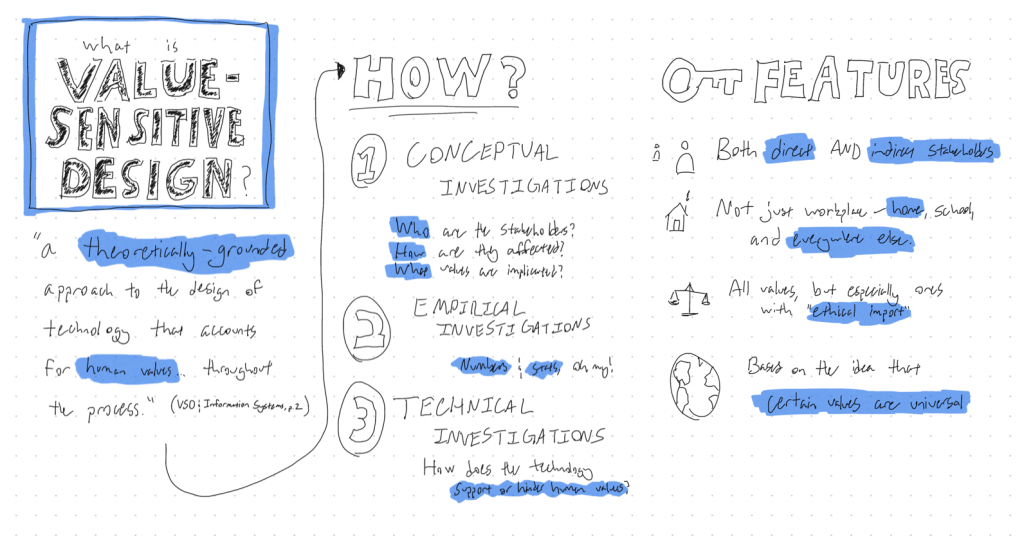
Another activity was to put together a presentation, going through some value-sensitive design processes and presenting our ‘findings.’ Of the available prompts, I chose the one that boiled down to “your team has just been hired to design a photo-sharing application; you’re in charge of the VSD portion. Go.”







The second unit in my course on User Experience and Evaluation was on competitive analysis — looking over the competitive landscape in a given marketplace, and using that data to figure out both the low-level design and high-level strategy you should use to effectively compete.
While I considered doing an analysis of the productivity management/to-do-list marketplace (an area on which I have many opinions), I realized that the end result of that analysis would be “the marketplace is saturated, and the ‘table stakes’ level of functionality is prohibitively expensive to achieve.” Not the most exciting result.
Instead, I looked at another area where I’ve gone through a surprising number of apps: fitness tracking. Specifically, workout planning and tracking – I did a previous assignment on how people use the gym, and one of my findings was “hoo boy are there a lot of different systems for planning and tracking a workout.”
After downloading quite a few apps and compiling a rather monstrous spreadsheet, I put together the results into a report, which I’m now posting here.
(Will I be using these findings to develop an app? … No comment.)
For those using screen readers, or who prefer their own reading environment, you can download the full presentation PDF here:



















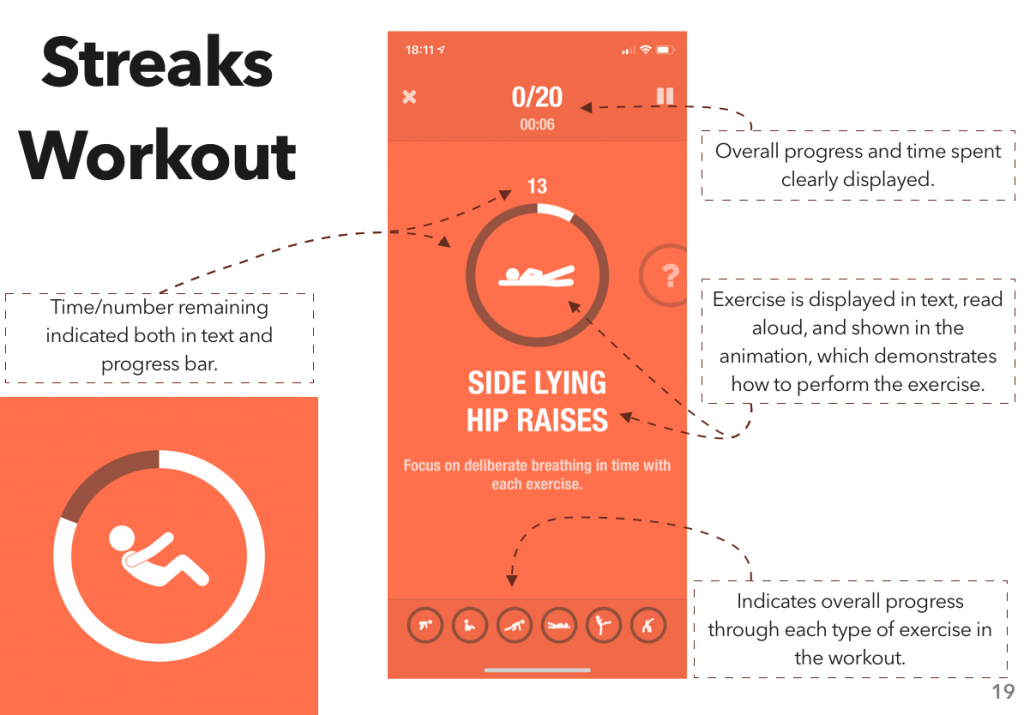









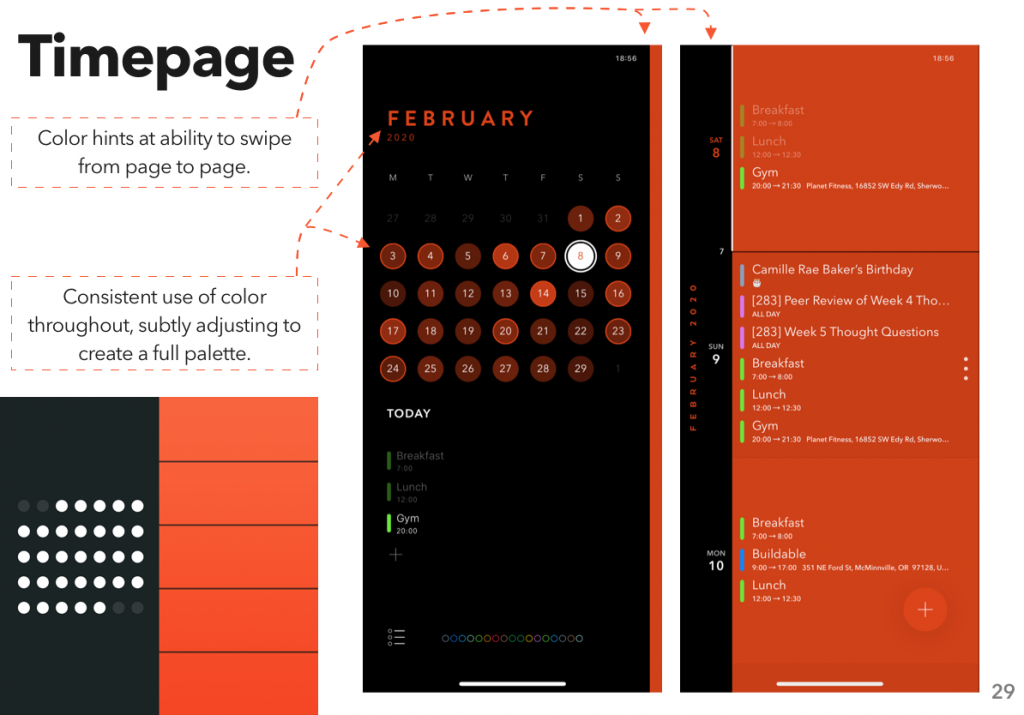





Don Sakers
I mentioned in my last review that I was reading this omnibus; I didn’t review the short story in the middle, as it seemed a bit too short to be worth the effort, but did enjoy it. And it provided a good introduction to the characters here, eased the transition of skipping forward half a millennium or so.
I’ll start off by saying that I enjoyed “Children of the Eighth Day,” but temper that by saying it wasn’t as good as “Dance for the Ivory Madonna.” It’s more removed — it’s a space opera, and I’m much less familiar with the goings-on of an interstellar empire than I am of the modern world.
The overall flow was interesting — the first half of the book wraps up far more than I thought it would, and the second half has an entirely different set of issues for the characters to confront.
In retrospect, I think the short story leading in to this is not just helpful, but perhaps necessary, to be able to at all follow the events of the first few chapters. Things kick off very quickly, and trying to figure out the context of the Empire and the Family would be a bit much in addition to the actual events of the plot.
Final verdict: I do recommend the omnibus as a whole, but it might be worth reading it out of order — there’s a bit of spoiler effect for “Ivory Madonna,” as historical context, but I don’t think it gives away enough to really ruin the book for you, if you do read it in that order.
Based on how this blog is going so far this year, I should retroactively declare my resolution to be “blog more.”
Silhouette by Aquilo on Silhouettes
Cologne by Haux on Something to Remember – EP
Sober by Edwin Raphael on Sober – Single
Coincidental by Betcha on Coincidental – Single
Connor by SYML on SYML
Falling Down by Harrison Storm on Falling Down – Single
Angel by H. Kenneth on Angel – Single
Fk Collingwood by Hayden Calnin on Fk Collingwood – Single
Hey, Ma by Bon Iver on Hey, Ma – Single
Haunted by Saint Claire on Haunted – Single
Crying at the Party by Harry Strange on Crying at the Party – EP
Cars at Night by By The Coast on Cars at Night – Single
Barrio by Mahmood on Barrio – Single
On Our Last Day by Hayden Calnin on A Life You Would Choose – EP
Tonight – Thorin Loeks on Tonight – Single
Cover Your Eyes by Black Match on Cover Your Eyes – Single
Hard Lines, Hard Times by William Wild on Hard Lines, Hard Times – Single
Tourner dans le vide (Slowed) by Unge Moped & Tuber on Tourner dans le vide : Man slowed down – Single
Without Fear – Dermot Kennedy on Without Fear
Hollow Coves – Firewoodisland on Hollow Coves – Single
Edge of the Ocean – By The Coast on You
Drive – OTR & Panama on Drive – Single
everything i wanted – Billie Eilish on everything i wanted – Single1
Symmetry – SYML on Symmetry – Single
Dolly Zoom – Elliot Moss on Boomerang
Closedloop – Elliot Moss on Boomerang
Don’t Take the Money – Harry Strange on Don’t Take the Money – Single
20 Something – Alexander 23 on I’m Sorry I Love You
Blue Tide Eyes – FLØRE on Blue Tide Eyes – Single
Bravado – Yoke Lore on Bravado / Body Parts – Single
Tightrope – Danny Bowens on Tightrope – Single
When I Need a Friend – Coldplay on Everyday Life
Hope – Balcony on Hope – Single
This is Where it Ends – Richard Walters on This is Where it Ends – Single
Back Around – Harry Strange on Back Around – Single
Dead Ringer – Yoke Lore on Dead Ringer – Single
Monsters – Lucy Daydream on Monsters – Single
Borders – Nathan Ball on Borders – Single
Silver + Gold – Elliot Moss on A Change in Diet
Eight – Haux & Rosie Carney on Eight – Single2
Need You – Kidswaste on Need You – Single
Raising Hell (feat. Big Freedia) – Kesha on High Road
Orphans – Coldplay on Everyday Life
Daddy – Coldplay on Everyday Life
Chanel – Frank Ocean on Chanel – Single
The Village – Wrabel on The Village – Single
Movements – Mild Minds on Movements – Single
I Don’t Wanna Die – Betcha on Falling – EP
Swing – Sofi Tukker on Swing – Single
Ghost – JacobNeverhill on Ghost – Single
Blind – INTET on Blind – Single
Hard Times (Acoustic) – RITUAL & Robinson on Hard Times (Acoustic) – Single
Èkó – Coldplay on Everyday Life
Million Pieces (feat. The Chamber Orchestra of London) – Bastille on Doom Days (This Got Out of Hand Edition)
Young Minds – Saavan on Observatory – EP3
Down – Griffin Stoller on Down – Single
notice me (feat. BENEE) – ROLE MODEL on oh, how perfect – EP4
Lucky Me (feat. Great Good Fine Ok) – The Knocks on Summer Series: 2019 – EP
Take Me Apart – SYML on Take Me Apart – Single
New Day – Benji Lewis on New Day – Single
Apollo – Charles Fauna on Apollo – Single
Happens to the Heart – Leonard Cohen on Thanks for the Dance5
Chewing Cotton Wool – The Japanese House on Chewing Cotton Wool – Single
Trouble in Town – Coldplay on Everyday Life
Hallelujah – Oh Wonder on No One Else Can Wear Your Crown (Deluxe)
Barricade – Elliot Moss on A Change in Diet
Rossetto – Random on Rossetto – Single
Time (feat. Muna) – Blewbird on Time (feat. Muna) – Single
Sober – Harry Strange on Sober – Single6
Saturn – Sleeping At Last on Atlas: Space 2 – EP
Stay – Alt Bloom on Stay – Single
Hvn – TEME on HVN – Single
Deja – Leo Islo on Deja – Single7
Lies (feat. H. Kenneth) – Syence on Lies (feat. H. Kenneth) – Single
Jericho – Westerman on Jericho – Single8
Bodyintoshapes – Elliot Moss on A Change in Diet
Picaflor – Lao Ra & C. Tangana on Picaflor – Single
Blinding Lights – The Weeknd on Blinding Lights – Single
Family (with Kygo) – The Chainsmokers & Kygo on World War Joy
hungover & i miss u – gnash on hungover & i miss u – Single
Chain – Lolo Zouaï on High Highs to Low Lows (Deluxe)
Top Dom – Avery Anthony on Top Dom – Single
Dancin (feat. Luvli) [Krono Remix] – Aaron Smith on Dancin (feat. Luvli) [Krono Remix] – Single
Demons – Alec Benjamin on Demons – Single
Rapide – Mahmood on Rapide – Single9
Rabbit Roads – Elliot Moss on A Change in Diet
Circles – Post Malone on Hollywood’s Bleeding
Wherever You Are – Kodaline on Wherever You Are – Single10
MIDDLE OF THE NIGHT – Elley Duhé on MIDDLE OF THE NIGHT – Single
Soil’s Daughter – Aisha Badru on Soil’s Daughter – Single11
Higher – Byron Langley on Light On – EP
In the Same Place – Elliot Moss on A Change in Diet
Eleven – Khalid on Eleven – Single
Father’s Son – Declan J Donovan on Homesick – EP
Phases (feat. Trove) – Go-Jo on Phases (feat. Trove) – Single